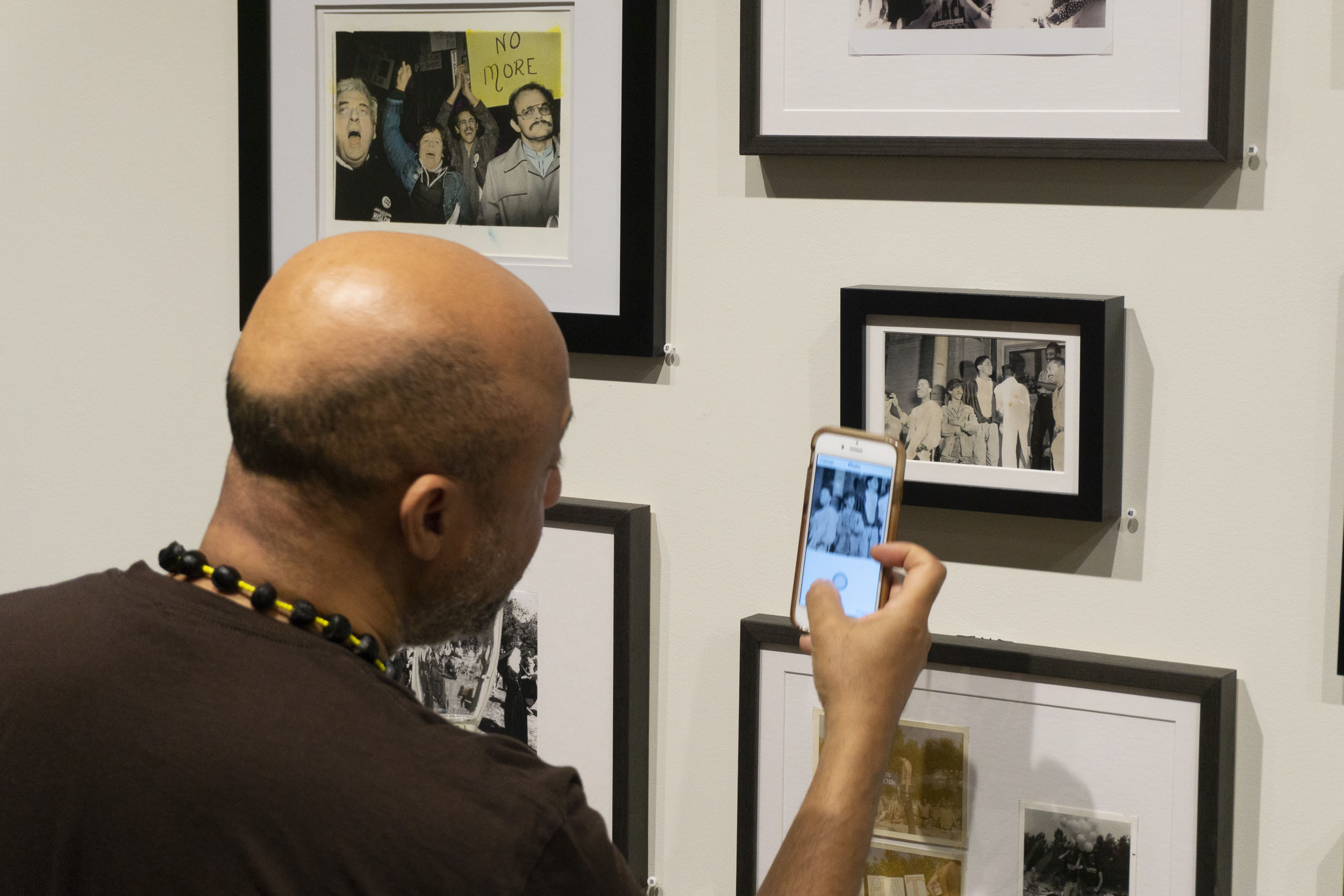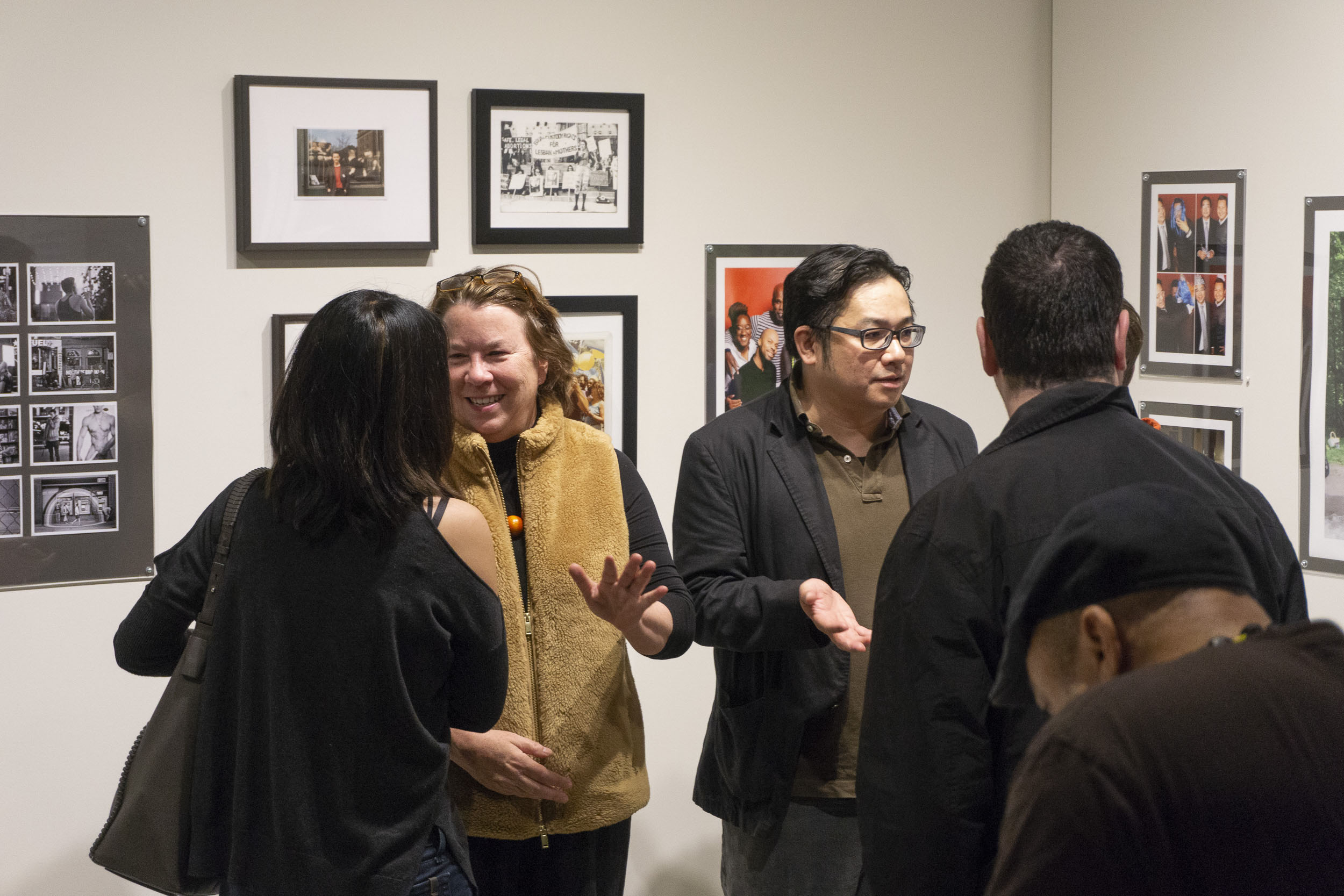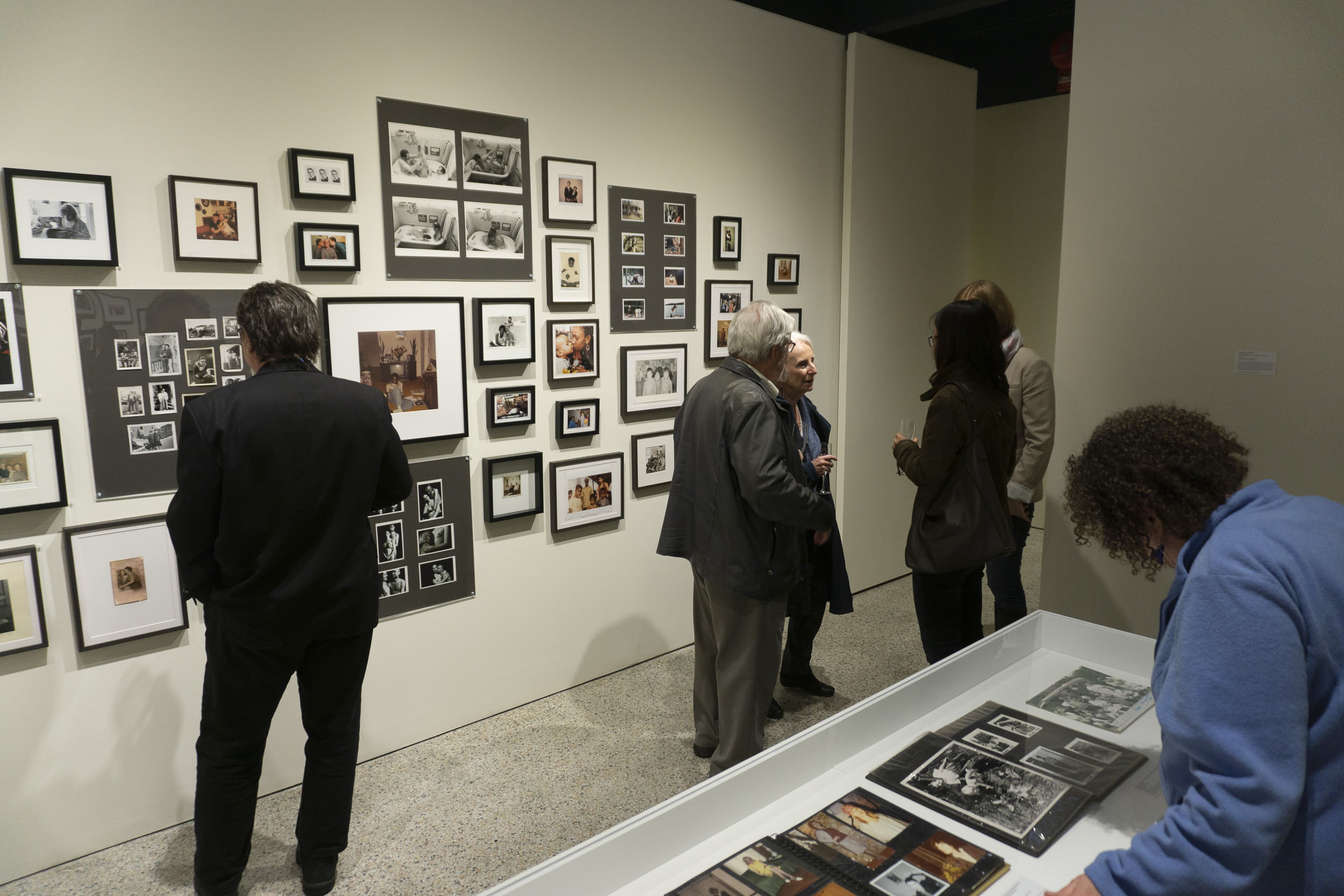Exhibition
Queering Family Photography (Apr. 21 – May 26, 2018)
Stephen Bulger Gallery, Toronto
Lead Curator: Elspeth Brown; Thy Phu, Co-Curator
Queering Family Photography
text by: Elspeth Brown (lead curator), Thy Phu (co-curator) and Jennifer Orpana
On April 21st, 2018, the Queering Family Photography exhibition opened at Stephen Bulger Gallery, in conjunction with artist Sunil Gupta’s exhibition, Friends and Lovers – Coming out in Montreal in the 70s.
Queering Family Photography explored the critical work that queer, trans, and two-spirited family photos do in documenting and creating queer modes of belonging, and how our emotional attachments to queer family photographs have also sustained LGBTQ2+ lives. The show traced how queer, trans, and two-spirited people draw on photography to redefine family to include queer kinships outside the heteronormative, nuclear family model. It considered the social, political, and technological factors that structure queer kinship, and the ways that LGBTQ2+ communities creatively reimagine family, linking public and private spheres together. The images on display captured fleeting moments of love and desire, as well as generational bonds, which are often fractured by a normalizing state and culture.
The exhibition featured over 100 photographs, as well as oral histories, collected through The Family Camera Network. It also included loans from the Canadian Lesbian and Gay Archives (CLGA), a partner in this project, and from the Two-Spirited Collection at the University of Winnipeg Archive. It was organized by The Family Camera Network and the Canadian Lesbian and Gay Archives, with the support of Western University, Stephen Bulger Gallery, and York University. It was curated by Elspeth Brown (lead) and Thy Phu, with the assistance of Sajdeep Soomal, Richard Fung, Mark Kasumovic, Tori Abel, Lucie Handley-Girard, and Sarah Parsons.
Queering Family Photography was on display from April 21st to May 27th and it was a featured exhibition in the Scotiabank CONTACT Photography Festival.
Thematic Sections
Queering Family Photography was presented in three thematic sections: Instant Intimacies, Domesticities, and Publics. The exhibition also included a selection of albums in vitrines, as well as a video projection that showcased FamCam participants and their stories.
Instant Intimacies
The first section of the exhibition explored photographic technologies that enabled a sense of “instant intimacy,” through a small selection of Polaroid photographs and prints of digital images. Candid Polaroid prints from the 1970s-1990s brought desires into view while limiting the threat of public exposure at a time when non-normative sexualities and genders were strictly surveilled and policed. This technology of instant intimacy has also captured and created camp, queer humour, and two-spirited kinship during moments of levity and connection. Although the demise of Polaroid coincided with the digital turn, its influence persists in the era of social media, which embraces the immediacy and spontaneity that older instant cameras introduced. In In “Instant Intimacies,” viewers experienced Polaroids of friends in hanging out, in drag, and at parties. The digital images in this section included: selfies, a screenshot from a LiveJournal chat room for trans women, and a screenshot of a son and his parents as they connect from their respective homes in Toronto, Canada and Mumbai, India.
Installation show of Domesticities wall. Photograph by Scott Poborsa, Stephen Bulger Gallery
Domesticities
Through a display of over thirty photographs hung in a salon style, “Domesticities” examined how family photos also shape domesticity as an ideology that forms gender roles and polices sexuality in a way that intersects with the public sphere. LGBTQ2+ people make and remake family by creating domestic images that redefine normative meanings of “daddies,” mothers, siblings, and kids. LGBTQ2+ people have reimagined these domestic descriptors in queer family photographs taken not only inside homes but also in public spaces: at the beach, in a stairwell, on the street, and elsewhere. “Domesticities” highlighted the generational bonds between parents and children, between romantic partners, and between strangers who, despite their brief connection, come together in defiance of norms and laws that criminalize queer desire and gender expression. Here, visitors saw the diverse types of images that compose family photo collections, including: baby pictures, school pictures, wedding photos, holiday snaps, commercial images, and press photos.
Alley Yapput, Stacy Status, and June Thunderchild at Pride in Toronto, 1992. Courtesy of the University of Winnipeg Archives, Two-Spirited Collection.
Publics
LGBTQ2+ people draw on photography to expand and queer the notion of family through spectacular and quotidian means, including the highly visible spaces of the street and park, and less visible spaces such as bathhouses, coffeehouses, and clubs. Both types of spaces are pivotal for expressing queer desire yet are targets for state suppression. Events such as powwows provide opportunities to reflect further on two-spirited kinship in relationship to Indigenous cultures and queer modes of belonging. In a neoliberal era, however, many queer family spaces have become gentrified and commodified in a process that benefits some LGBTQ2+ community members while marginalizing others on the basis of class and race. The “Publics” section included photos taken during demonstrations and pride events, including images capturing: the “No More Shit” demonstration against the Toronto bathhouse raids (1981), a Zami gathering (1983), a Gay Men of African Descent march (1995), a Campaign for Equal Families demonstration (1995) and the 22nd Annual International Two-Spirit Gathering (2010).
Photography of one of two album vatrines. Photograph by Scott Poborsa, Stephen Bulger Gallery.
Albums
The CLGA collection contains several family albums, which document travels and migrations, capture everyday moments and significant events, represent chosen families, memorialize friends and family members, and even acknowledge public figures in the medical profession who have been advocates for LGBTQ2+ people. The exhibition included a selection of these family photo albums and album pages in two vitrines. Some of these items included: a page with a “Spirituality in the 1990s” flyer by two-spirit activist Albert McLeod, Rupert Raj’s personal photo album featuring his crossdressing friends, a family album with snapshots of author and photographer Terry David Silvercloud growing up in Halifax, and an album with snapshots of Robert ‘Robbie’ Gaston Fortin, a Toronto and Vancouver-based Drag Star (a.k.a. Mrs. Wiggins), that was created by his mother for the Drag Hall of Fame after he passed away.
Video Projection: Queering Family Photography (2018)
A large projection on the north wall of the exhibition space presented an original video directed by Thy Phu, and edited and animated by Maryam Golafshani and Mark Kasumovic, showing clips from oral history interviews collected by The Family Camera Network. In May 2016, The Family Camera Network launched a public archive project to collect and preserve family photographs and their stories, providing a resource for teachers, historians, and scholars to write new histories of photography, family, and Canada. At the time of the exhibition, the project had conducted over 30 interviews, including 16 oral history interviews with 13 queer and trans narrators about their family photographs. FamCam photographs and video interviews are preserved at the Canadian Lesbian and Gay Archives and at the Royal Ontario Museum. This video draws from interview footage in the FamCam archive at the CLGA.
Exhibition Outreach & Programming
Queering Family Photography reached broad audiences as one of the featured exhibitions of the Scotiabank CONTACT Photography Festival. Around 300 people visited the gallery during the opening and the show saw between 25 to 50 visitors a day during its run. Several attendees wrote comments in the guestbook that expressed appreciation and gratitude for presenting a show that highlighted LGBTQ2+ experiences and families.
Queering Family Photography: Roundtable, University of Toronto, Hart House Thursday April 26, 2018. Featuring: renowned artist Sunil Gupta (UK), acclaimed filmmaker Richard Fung (Canada) and prominent Two-Spirited activist Albert McLeod in conversation with co-curators Elspeth Brown and Thy Phu
Remarking on the show and the audience it garnered at the gallery, Stephen Bulger commented
It was a distinct honour to offer some of our gallery space for the Queering Family Photography exhibition. CLGA’s initiative enabled Sunil Gupta to explore an old body of work for the first time which, when presented in conjunction with the archival treasures from the CLGA served to broaden the issues depicted. I also enjoyed seeing how the two exhibitions would often each attract its own audience, and how delighted they would be to discover a second, complimentary exhibition. Coupled with the audience attracted to the CONTACT festival, it would be hard to imagine a more perfect time to have hosted the two exhibitions.
The Family Camera Network also hosted a Queering Family Photography roundtable on April 26th, 2018. Acclaimed filmmaker Richard Fung moderated a panel featuring prominent Two-Spirited activist Albert McLeod, artist Sunil Gupta, and curators Elspeth Brown and Thy Phu. It was held at Hart House (University of Toronto) and explored the themes and content of the Queering Family Photography and Friends and Lovers - Coming Out in Montreal in the 70s. This free public panel drew an audience of over 60 people.
Appearing on CBC's Metro Morning with Matt Galloway, 20 April 2018
In the Media
Queering Family Photography was well-received in the media. It was hailed as a “must-see” exhibition of the Scotiabank CONTACT Photography Festival in Canadian Art and the Toronto Star. Associate Editor of Canadian Art, Yaniya Lee, wrote:
Growing up, I rarely saw representations of my own, two-momed type of family unit. For a long time I had the odd sense that these kinships were strange, illegitimate or shameful. In “Queering Family Photography,” Elspeth Brown and Thy Phu have combed through the Family Camera Network, the Canadian Lesbian and Gay Archives and the University of Winnipeg Two-Spirited Collection to present this collection of queer and trans family photos. IMHO, portrayals of alternative family structures like these, so seldom given a space to be visible, can shift our perception of what a “normal” family should look like. (26 April 2018)
Art critic Murray Whyte drew a connection between The Family Camera (Royal Ontario Museum, 2017) and Queering Family Photography, and noted that the images on display were, “warm in their simple truth – of the intimacy and comfort of nearest and dearest, a universal necessity that knows no gender or orientation.” Interviews with lead curator Elspeth Brown were also featured on Metro Morning, Toronto Life, Yohomo: Toronto Queer Culture Now, and CBC Arts.
Click here for media about Queering Family Photography
Exhibition Team
Curators: Elspeth Brown (lead) and Thy Phu with Sajdeep Soomal
Exhibition Design: Thanh Phu
Collection Technician & Preparator: Tori Abel
Installation: Scott Poborsa










